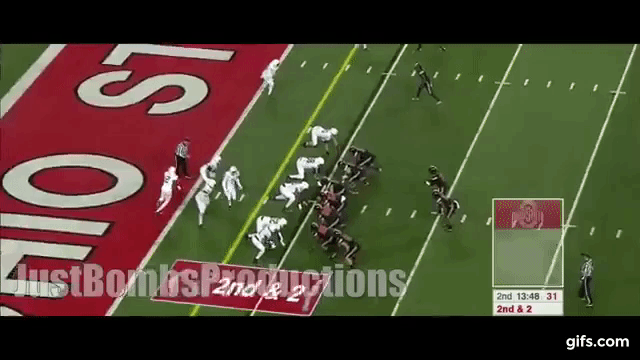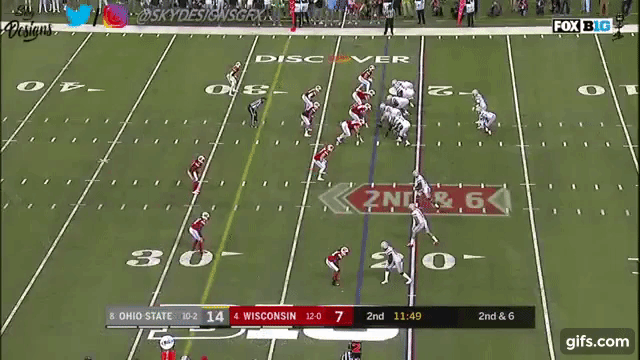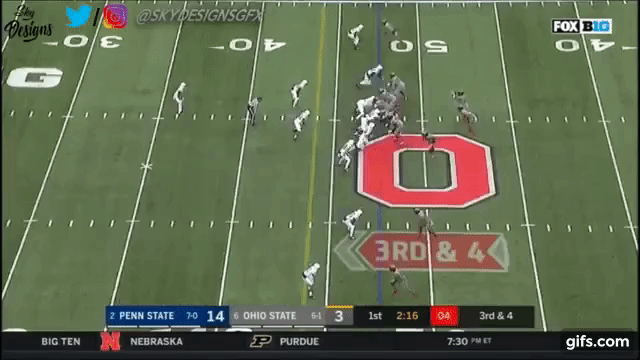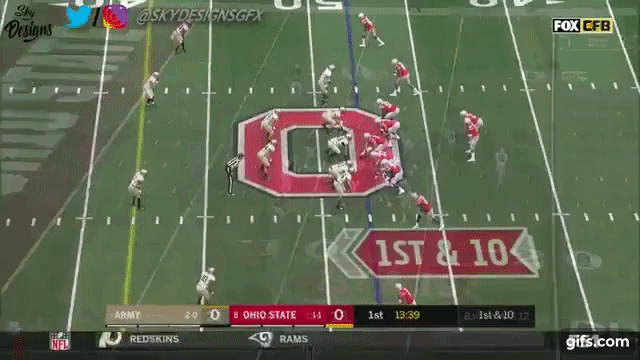Inside the Playbook: Ohio State's Book and Run Scheme and Arrow/Slide RPO
Everybody knows the basic zone read scheme. Block inside zone (or one of many types of zone) while leaving the backside DE unblocked for the QB to read. If the DE crashes the mesh point, the QB pulls and runs off the backside. If the DE stays home, the QB gives to the RB who runs basic inside zone.
But as defenses get more athletic and more nuanced in their defense of zone read, making this "read" becomes more challenging for the QB. You now have games like scrape exchange, where the DE crashes and the LB fills behind. You have more athletic edge players that can force a give but get back into the play from the backside. One option is to change the read defender, another option is to utilize additional backs to modify the blocking scheme. In this post, I'll talk about an option that utilizes a little of both which dates back to Meyer's time at Florida, in the Book and Rifle schemes.
Book/Bible Scheme
Book, like it's kindred spirit "Bible", is a play which utilizes a TE/H-Back/FB in order to seal the defender outside the read player (or in some rare cases, two defenders outside the red defender). Where "Bible" initially looks like split zone, only to see the blocker arc around to the second level, "Book" starts from the backside of the play and arcs to the second level from there.
The read player is always the second DL to the backside of the play (head up on the Center is considered backside). Depending on the alignment of the 3rd and 4th defenders to the backside, the BST may take #3 and the TE #4, but these cases are rare.
There are a few benefits to this Book scheme:
Here's an example of a "Double Book", because there is a TE/Wing combo to the backside. Both "Book" block, with the TE taking #3 backside and the Wing looping to the second level, allowing the DE to spike inside.
Against Oklahoma, OSU ran "Rifle" in which the BST initially steps down. The DE tries to attack, loses balance, and runs past the play. Blocking the more athletic OLB keeps him stuck to the backside of the play, and the RB has an easy cutback for the TD.
Here it is with the slide RPO. In this case, OSU uses the slot motion. And poor Army looks all sorts of lost with what to do here (watch the play side safety run to no where).
But as defenses get more athletic and more nuanced in their defense of zone read, making this "read" becomes more challenging for the QB. You now have games like scrape exchange, where the DE crashes and the LB fills behind. You have more athletic edge players that can force a give but get back into the play from the backside. One option is to change the read defender, another option is to utilize additional backs to modify the blocking scheme. In this post, I'll talk about an option that utilizes a little of both which dates back to Meyer's time at Florida, in the Book and Rifle schemes.
Book/Bible Scheme
Book, like it's kindred spirit "Bible", is a play which utilizes a TE/H-Back/FB in order to seal the defender outside the read player (or in some rare cases, two defenders outside the red defender). Where "Bible" initially looks like split zone, only to see the blocker arc around to the second level, "Book" starts from the backside of the play and arcs to the second level from there.
The read player is always the second DL to the backside of the play (head up on the Center is considered backside). Depending on the alignment of the 3rd and 4th defenders to the backside, the BST may take #3 and the TE #4, but these cases are rare.
There are a few benefits to this Book scheme:
- The arcing blocker can influence the DE to widen. Most defenders are playing block-down, step-down rules. Having the TE arc outside of them will often cause them to widen as their initial read tells them to work not to reached. With this, you can often get a sort of 2 for 1 block with the TE alone, taking the DE out of the play and blocking an overhang defender from scraping back inside.
- With teams applying scrape exchange and other games with the contain defender (allowing the DE to crash), this makes the QB read easier. In this way the defense wants to utilize a defender other than the DE to contain the QB, now that defender is blocked, and if the QB keeps, the DE has crashed on the RB and taken himself out of the play.
- Similar to the previous two points: this makes the QB run threat stronger, as he now has a lead blocker. This can sometimes twist the defensive backfield and prevent third level defenders from inserting themselves inside to defend the RB. In this way, you are spreading out the defense post snap.
Bible, while like Book in its final execution, stresses the defense a bit differently because it looks initially like split zone. In this way, Bible compells the backside DE to follow his block-down, step-down rules in order to defend against being "trapped". Particularly against teams that love to "wrong arm" (also discussed in the block-down link), this "Bible" look will intice the DE to work inside to squeeze the backside of the play down. But as he over-commits to the backside of the play, the TE can arc block around to a second level defender, helping the QB run in the process.
Book Examples
Here is a basic "Book" call. The TE here is going to let the DE go (who scrapes really far inside instead of attacking down hill) and immediately blocks the NB coming off the edge. This allows the BST to work immediately to the backside ILB, take care of that block, and it's a relatively clean run for the QB into the end zone.
Here's an example of a "Double Book", because there is a TE/Wing combo to the backside. Both "Book" block, with the TE taking #3 backside and the Wing looping to the second level, allowing the DE to spike inside.
You're really getting a two-fer here. This is an example of "Bible", but also includes an example of "Loop" call (look at the next section) in which the BST first steps down to influence the DE, and then loops to the second level. In this case, the DE flies inside after the RB because an outside player is supposed to have contain. But both outside players are blocked by the "Loop" and the "Bible" blocks.
Rifle
Rifle is effectively the same idea as "Book" but with the BST rather than a TE/H-Back/FB. It can be utilized as a line call against certain looks, or it can be used similar to the book scheme as a playcall. Depending on the defensive alignment, the BST will either initially step inside (to cut off the immediate free run from the DE) or will immediately work to the outside defender. He can either kick out the third defender outside ("rifle") or can "Loop" to the second level.
Rifle Examples
Against Oklahoma, OSU ran "Rifle" in which the BST initially steps down. The DE tries to attack, loses balance, and runs past the play. Blocking the more athletic OLB keeps him stuck to the backside of the play, and the RB has an easy cutback for the TD.
And from the end zone, look at the good angle the BSG has to the LB without having to worry about helping on the DE
Same thing against Wisconsin in the Big Ten Championship Game. The DE attacks down hill and can't redirect fast enough to bring down the RB.
Here it is later in the same game helping the "keep" read: LINK
Same thing against Wisconsin in the Big Ten Championship Game. The DE attacks down hill and can't redirect fast enough to bring down the RB.
Here it is later in the same game helping the "keep" read: LINK
Arrow/Slide RPO
Lastly, let's explore the same sort of concept, but now we are replacing the backside block with an arrow route. I will be the first to say that I was highly skeptical of this RPO. The angle for this throw forces it to need to be highly accurate (over the correct shoulder and not outside the frame of the body) while on the move with often inconsistent hand placement (ball handling becomes a point of emphasis to get this out on time). Similarly, it can be a tricky catch for the receiver, who has an awkward angle with his route and pass (effectively running away from the QB) with little time to adjust his hands while the ball is in the air. Yet, as we saw from OSU, PSU, and Oklahoma, apparently it can be made to look extremely easy, as each team used it very effectively in 2017.
There are again two different examples of this: the arrow screen, which works like "Book" to "block" a backside defender with the TE starting in that direction; and "slide" which initially looks like split zone, but has the same impact on the defense.
Here you see how the Arrow RPO pulls a defender completely away from the ball, allowing for the RB to cut back
Lastly, let's explore the same sort of concept, but now we are replacing the backside block with an arrow route. I will be the first to say that I was highly skeptical of this RPO. The angle for this throw forces it to need to be highly accurate (over the correct shoulder and not outside the frame of the body) while on the move with often inconsistent hand placement (ball handling becomes a point of emphasis to get this out on time). Similarly, it can be a tricky catch for the receiver, who has an awkward angle with his route and pass (effectively running away from the QB) with little time to adjust his hands while the ball is in the air. Yet, as we saw from OSU, PSU, and Oklahoma, apparently it can be made to look extremely easy, as each team used it very effectively in 2017.
There are again two different examples of this: the arrow screen, which works like "Book" to "block" a backside defender with the TE starting in that direction; and "slide" which initially looks like split zone, but has the same impact on the defense.
Here you see how the Arrow RPO pulls a defender completely away from the ball, allowing for the RB to cut back
Here it is with the slide RPO. In this case, OSU uses the slot motion. And poor Army looks all sorts of lost with what to do here (watch the play side safety run to no where).
I'd be remiss not to show PSU running the same scheme, as they ran it more than anyone last year
2x2 condensed formation by PSU. Inside zone + slide screen #RPO. DE crashes on RB so QB pulls and throws the slide screen to the H Back for a nice gain on 1st down pic.twitter.com/ie5Bjqu6y4— icoachtowin (@1coachtow1n) July 23, 2018





















Comments
Post a Comment